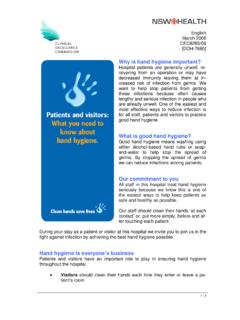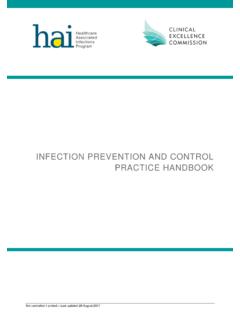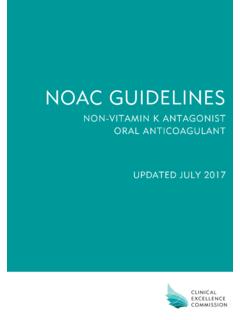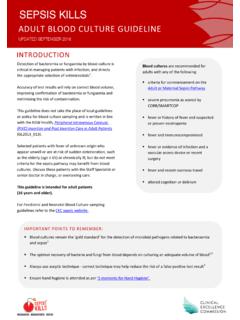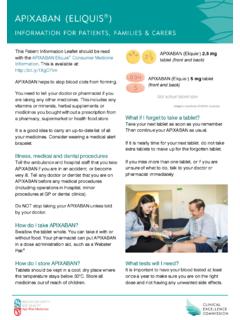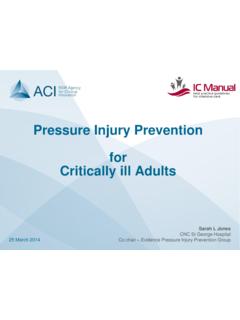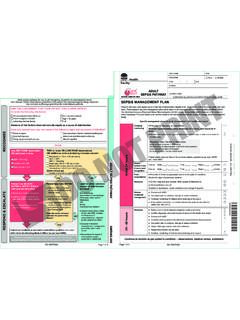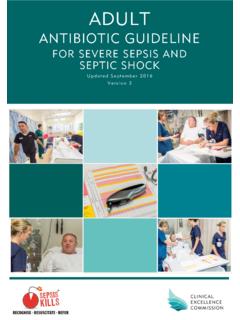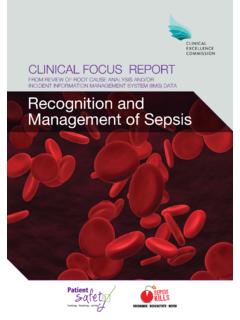Transcription of LACTATE INFORMATION SHEET - NSW Health
1 LACTATE INFORMATION SHEET FOR CLINICIANS LACTATE is a normal product of anaerobic cell metabolism and is released into the blood and metabolised by the liver. It is produced in large amounts when there is insufficient oxygen for activity in the LACTATE production can be increased in conditions that cause inadequate oxygen delivery, such as trauma, as well as in conditions that have disproportionate oxygen demands such as hyperthermia and Some medications such as salbutamol, metformin, phenformin and HIV drugs can also cause high LACTATE Normal LACTATE levels are less than mmol/L in both arterial and venous blood. Elevated serum LACTATE level is strongly associated with morbidity and mortality in critically ill patients. One study showed a level above was associated with a 27% mortality rate compared with 7% for patients with a LACTATE of mmol/L2.
2 LACTATE in sepsis Elevated LACTATE is typically present in patients with severe sepsis or septic shock and has clinical and statistical significance in predicting mortality in patients with , 5 Measurement of LACTATE in all septic patients is a simple strategy that may assist clinicians to more effectively manage the care of septic patients and improve The NSW Between the Flags system mandates that a patient with a LACTATE of mmol/L or more should activate a Rapid Response with immediate intervention by a team of critical care experts. LACTATE and cryptic shock Cryptic shock is defined as a serum LACTATE greater than 4 mmol/L with a systolic blood pressure of at least 90mmHg. 7 Severe sepsis with cryptic shock has a mortality rate similar to that of patients with overt septic shock. Serum LACTATE should be screened in all patients who are suspected of severe infection and sepsis, irrespective of blood pressure and the appearance of being well-perfused.
3 LACTATE clearance Serial LACTATE measures can assist in monitoring treatment , 9 LACTATE clearance of at least 10% at a minimum of 2 hours after resuscitation initiation is a valid way to assess initial response to resuscitation in severe LACTATE in children Elevated LACTATE is a late sign of sepsis in children. Where LACTATE is greater than 2 mmol/L and sepsis is suspected, it is recommended that immediate treatment is commenced. Key messages Measurement of serum LACTATE should be undertaken in all patients with suspected infection. Adults with a LACTATE greater than 4 mmol/L should receive aggressive resuscitation, regardless of blood pressure. Children with a LACTATE greater than 2 mmol/L should be urgently reviewed by a senior clinician and treatment commenced. All patients with a LACTATE greater than 4 mmol/L should be admitted to intensive care unless there are limitations in treatment.
4 Frequently asked questions Do I need a venous or arterial blood sample? Obtaining a venous blood sample is often easier and less painful for the patient. Studies show that both venous and arterial blood can be used for LACTATE , 10, 11 Do I need to take the tourniquet off before drawing a venous sample? No, but the blood should be drawn within 2 minutes as LACTATE levels can be elevated with prolonged application of a tourniquet. Once the blood is drawn do I need to take any measures to preserve the sample? Ideally the sample will be tested within a short space of time (less than 1 hour) to allow rapid management of the patient. If this is not possible a grey-top tube (fluoride oxalate) can stabilise the sample for later testing. Is point of care testing accurate? Point of care testing can be used provided validated equipment is used, users are trained and a quality control system is in place.
5 The local pathology laboratory can advise on this. What should I do if I think the LACTATE result is falsely elevated? Repeat the blood test in 30 minutes to confirm the result. If the patient is floridly unwell, do not delay in administering sepsis treatment as per the sepsis pathway in consultation with a senior clinician. References 1. EM Crit Blog (internet) 2014. Last accessed 26 Feb 2014 at 2. Boschert, S. Is it Septic Shock? Check LACTATE Level ACEP News [internet]. 2007. Cited 2014 February 26. Available from: 3. Vernon C, LeTourneau JL. Lactic acidosis: recognition, Kinetics and Associated Prognosis. Critical Care ; 26:255-283 4. Howell MD, Donnino M, Clardy et al. Occult hypoperfusion and mortality in patient with suspected infection. Intensive Care Med 2007; 33(11):1892-1899 5. Kerr J, Murphy P, Taktakishvili O et al. LACTATE Clearance Rates: A New Predictor of Mortality in Severe Sepsis and Septic Shock.
6 Annals of Emerg Med. 2010;56;3:46 6. Mikkelsen M, Miltiades AN, Gaieski DF et al. Serum LACTATE is aassociated with mortality in severe sepsis independent of organ failure and shock. Crit Care Med 2009; 37;5:1670-77 7. Puskarich M, Trzeciak S, Shapiro N et al. Outcomes of Patients Undergoing Early Sepsis Resuscitation for Cryptic Shock Compared with Overt Shock. Resuscitation. Author manuscript; available in PMC 2012 October in final edited form as: Resuscitation. 2011 October; 82(10): 1289 1293. Published online 2011 June 23. doi: 8. Jones AE. LACTATE Clearance for Assessing Response to Resuscitation in Severe Sepsis. Acad Emerg Med 2013; 844-7 9. Blomkalns AL. LACTATE -a marker for sepsis and trauma. (internet) 2007. Last accessed 3 April 2014 at 10. Younger JG, Falk JL, Rothrock SG. Relationship between arterial and peripheral venous LACTATE levels. Acad Emerg Med 1996;3:730-4 11.
7 Middleton P, Kelly AM, Brown J, Robertson M. Agreement between arterial and central venous values for pH, bicarbonate base excess, and LACTATE . Emerg Med J 2006; 23:622 About the Clinical Excellence Commission The Clinical Excellence Commission (CEC) has a central role in the responsibility for quality and safety in the NSW Health system. It was established in 2004 to promote and support improved clinical care, safety and quality across NSW. The CEC s SEPSIS KILLS program works with doctors, nurses and Health service managers to improve the recognition and treatment of severe infection and sepsis, to reduce its impact, mortality and financial costs in NSW. For further INFORMATION on the SEPSIS KILLS program, please visit: SEPSIS KILLS LACTATE INFORMATION SHEET for clinical staff. Released May 2014, Clinical Excellence Commission 2014.
